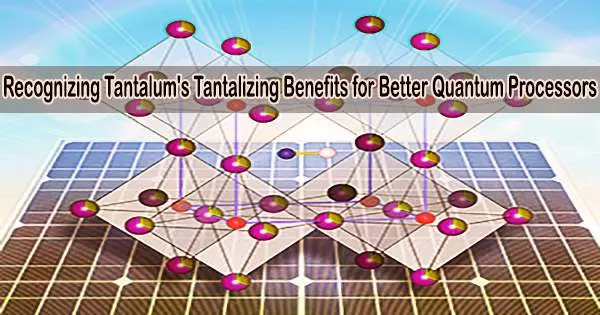It doesn’t matter if you’re making a cake, a house, or a quantum device; the quality of the finished result is greatly influenced by the materials used in its construction. In an effort to lengthen the coherence lifetimes of superconducting qubits, the building blocks of quantum computers, researchers have been experimenting with various base materials.
A qubit’s coherence time, which measures how long it holds quantum information, serves as a key performance indicator. Tantalum has recently been found to improve the performance of superconducting qubits, but until now, no one has been able to explain why.
Scientists from the Center for Functional Nanomaterials (CFN), the National Synchrotron Light Source II (NSLS-II), the Co-design Center for Quantum Advantage (C2QA), and Princeton University investigated the fundamental reasons that these qubits perform better by decoding the chemical profile of tantalum.
The research’s findings, which were just published in the journal Advanced Science, will be crucial in the development of future qubit designs that are even better. US Department of Energy (DOE) Office of Science User Facilities at DOE’s Brookhaven National Laboratory include CFN and NSLS-II. C2QA is a Brookhaven-led national quantum information science research center, of which Princeton University is a key partner.
Finding the right ingredient
Tantalum is a unique and versatile metal. It’s dense, hard, and easy to work with. Tantalum is beneficial in numerous industrial applications since it also has a high melting point and is corrosion-resistant. Tantalum is also a superconductor, which means that when cooled to extremely low temperatures, it has no electrical resistance and may conduct current without wasting any energy.
Superconducting qubits made of tantalum have shown record-breaking lifetimes of over half a millisecond. That is five times longer than the lifespan of niobium and aluminum-based qubits used in large-scale quantum processors at the moment.
Tantalum is a great candidate material for creating improved qubits because of these characteristics. Nevertheless, the quest to enhance superconducting quantum computers has been hampered by a lack of comprehension of what is restricting qubit lifetimes, a phenomenon known as decoherence. Although scientists are unaware of the precise causes and mechanisms, noise and tiny sources of dielectric loss are usually assumed to be involved.
“The work in this paper is one of two parallel studies aiming to address a grand challenge in qubit fabrication,” explained Nathalie de Leon, an associate professor of electrical and computer engineering at Princeton University and the materials thrust leader for C2QA. “Nobody has proposed a microscopic, atomistic model for loss that explains all the observed behavior and then was able to show that their model limits a particular device. This requires measurement techniques that are precise and quantitative, as well as sophisticated data analysis.”
Surprising results
Scientists at Princeton and CFN created and chemically treated tantalum sheets on sapphire substrates to acquire a clearer idea of the cause of qubit decoherence. They then took these samples to the Spectroscopy Soft and Tender Beamlines (SST-1 and SST-2) at NSLS-II to study the tantalum oxide that formed on the surface using x-ray photoelectron spectroscopy (XPS).
The work in this paper is one of two parallel studies aiming to address a grand challenge in qubit fabrication. Nobody has proposed a microscopic, atomistic model for loss that explains all the observed behavior and then was able to show that their model limits a particular device. This requires measurement techniques that are precise and quantitative, as well as sophisticated data analysis.
Professor Nathalie de Leon
With the help of x-rays, which are used to eject electrons from the sample, XPS can reveal information on the chemical makeup and electrical state of atoms close to the sample surface. Given that tantalum has a thinner oxide layer than niobium, which is more frequently employed in qubits, the researchers speculated that the thickness and chemical make-up of this tantalum oxide layer affected the qubit coherence.
“We measured these materials at the beamlines in order to better understand what was happening,” explained Andrew Walter, a lead beamline scientist in NSLS-II’s soft x-ray scattering & spectroscopy program. “There was an assumption that the tantalum oxide layer was fairly uniform, but our measurements showed that it’s not uniform at all. It’s always more interesting when you uncover an answer you don’t expect because that’s when you learn something.”
The team’s discovery of several tantalum oxides at the tantalum’s surface has raised fresh concerns regarding the development of more effective superconducting qubits. Can these interfaces be modified to improve overall device performance, and which modifications would provide the most benefit? What kinds of surface treatments can be used to minimize loss?
Embodying the spirit of codesign
“It was inspiring to see experts of very different backgrounds coming together to solve a common problem,” said Mingzhao Liu, a materials scientist at CFN and the materials subthrust leader in C2QA. “This was a highly collaborative effort, pooling together the facilities, resources, and expertise shared between all of our facilities. From a materials science standpoint, it was exciting to create these samples and be an integral part of this research.”
Walter said, “Work like this speaks to the way C2QA was built. The electrical engineers from Princeton University contributed a lot to device management, design, data analysis, and testing. The materials group at CFN grew and processed samples and materials. My group at NSLS-II characterized these materials and their electronic properties.”
These specialist groups coming together helped the study proceed more quickly and effectively while also providing the researchers with a wider perspective on their work. Students and postdocs had the opportunity to gain priceless expertise across a variety of fields and make significant contributions to this study.
“Sometimes, when materials scientists work with physicists, they’ll hand off their materials and wait to hear back regarding results,” said de Leon, “but our team was working hand-in-hand, developing new methods along the way that could be broadly used at the beamline going forward.”





